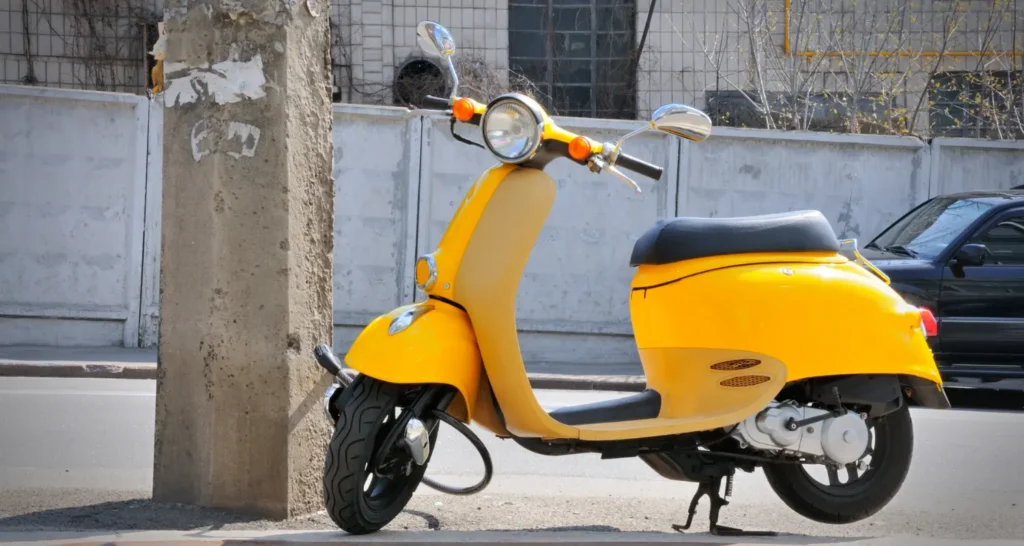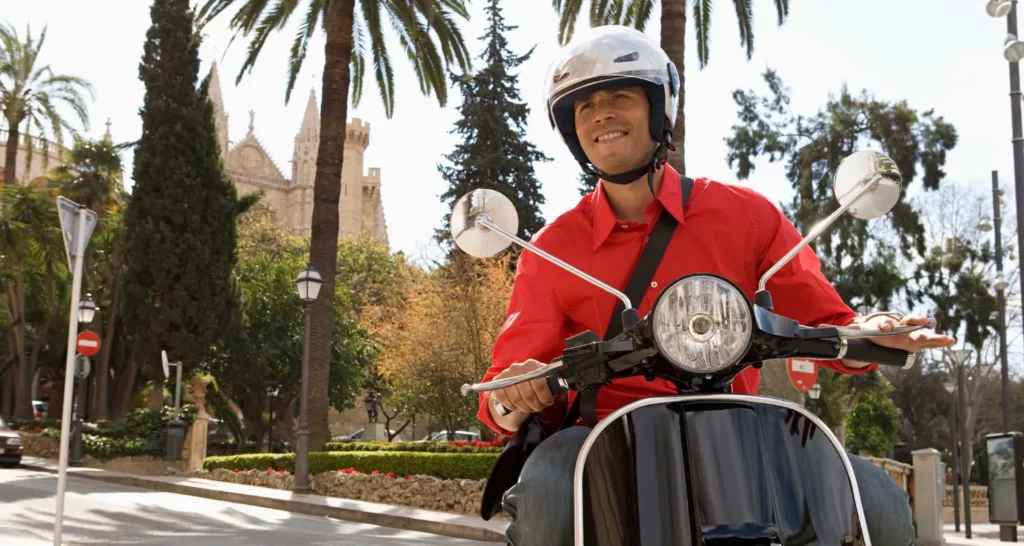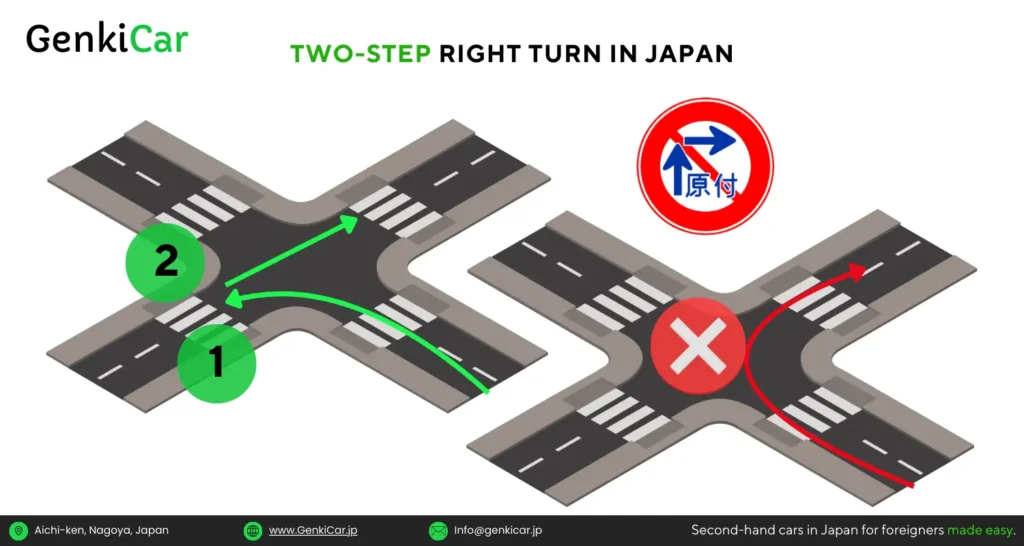Moped in Japan, known as 原付 (Gentsuki), are small motorized two-wheelers with an engine displacement of 50cc or less. They are classified as 原動機付自転車 (Gendōki-tsuki Jitensha), meaning “motorized bicycles.” Due to their compact size, fuel efficiency, and affordability, mopeds are widely used in urban areas for commuting and deliveries, as well as in rural areas where public transportation is limited.
Mopeds in Japan are categorized based on engine size:
- Class 1 Moped (原付一種, Gentsuki Isshu): 50cc or less, requiring a specific moped license.
- Class 2 Moped (原付二種, Gentsuki Nishu): 51cc–125cc, offering more power and higher speed limits but requiring a different license.
Difference Between Mopeds, Scooters, and Motorcycles
While the terms “moped” and “scooter” are often used interchangeably, there are some littile differences:
- Mopeds (Gentsuki): Limited to 50cc or less, subject to strict traffic regulations, including a 30 km/h speed limit and a special moped license requirement.
- Scooters: Typically have a larger engine (50cc–250cc or more) and do not fall under the same regulations as mopeds. They require a motorcycle license (A1 or higher) They are often used for faster commuting.
- Motorcycles: Range from 51cc to over 400cc, requiring categories such as A1 (up to 125cc), A2 (up to 400cc), and A (unrestricted).
How Are Mopeds Classified in Japan?

Class 1 Moped (Gentsuki Isshu) (50cc and Below)
The Class 1 Moped (Gentsuki Isshu) is the most common type of moped in Japan, featuring engines 50cc or smaller. These mopeds are highly popular for short-distance commuting, running errands, and navigating narrow city streets. To operate a Class 1 Moped, riders must obtain a moped license (Gentsuki Menkyo) and adhere to specific traffic regulations, such as the 30 km/h speed limit. These vehicles are well-suited for beginners due to their lower operating costs and easier handling.
Class 2 Moped (Gentsuki Nishu) (51cc–125cc)
The Class 2 Moped (Gentsuki Nishu) has a larger engine displacement, typically ranging from 51cc to 125cc. This class offers more power, allowing for higher speeds and greater versatility. Riders of Class 2 Mopeds must hold a motorcycle license, as the vehicle’s engine size exceeds the limit for a standard moped license. Although they can go faster than Class 1 mopeds, these vehicles still operate under specific regulations, including road restrictions and safety requirements like helmets.
Looking for a trusted dealership? Let us help! Get in touch for a list of top-rated, English-speaking dealers nearby.
How to Get a Moped License in Japan?
Eligibility Requirements
To obtain a moped license (Gentsuki Menkyo) in Japan, applicants must meet the following eligibility criteria:
- Age: Applicants must be at least 16 years old to qualify for a Class 1 Moped license (Gentsuki Isshu).
- Vision: Applicants need to meet a vision standard of 0.5 or better (with correction).
- Residency: Foreign applicants must provide proof of legal residency in Japan. Some prefectures offer exams in multiple languages for non-Japanese speakers.
If you’re looking for a comprehensive guide to obtaining a driver’s license in Japan, check out our Ultimate Guide to Driving License in Japan, which covers everything you need to know about licensing requirements.
Written Exam Details and Passing Criteria
The written exam for a moped license is designed to assess knowledge of traffic rules and regulations specific to mopeds. The test consists of:
- 46 multiple-choice questions on road signs, safety rules, and general traffic knowledge.
- 2 illustrated questions to test understanding of common traffic scenarios.
- The exam is 30 minutes long.
To pass, applicants must score at least 90% (41 correct answers out of 46). The passing score reflects the importance of safety and road awareness for moped riders.
We also highly recommend reading the “Rules of the Road” book by JAF before taking the test.
Practical Training Process
After passing the written exam, applicants must complete a 3-hour practical training session at a designated facility. This training covers:
- Basic operations, such as starting, stopping, and turning the moped.
- Safe riding techniques, including how to balance and handle the vehicle at different speeds.
- Traffic maneuvering and understanding moped-specific traffic rules.
This hands-on training ensures that all moped riders are well-prepared for real-world riding conditions.
Cost and Time Required to Obtain a License
The total cost for obtaining a moped license (Gentsuki Menkyo) in Japan is approximately 8,050 yen. This includes:
- Exam fees
- Practical training costs
- License issuance fees
The process typically takes half a day, with the license being issued on the same day once the applicant has completed all necessary steps.
What Are the Rules and Regulations for Mopeds in Japan?

Speed Limits and Road Usage Restrictions
Mopeds in Japan are subject to specific speed limits and road usage restrictions to ensure rider safety and maintain traffic flow:
- Speed Limit: The maximum speed for mopeds (Gentsuki) on general roads is 30 km/h. This speed limit applies regardless of road conditions, making mopeds a slower but safer option for city commuting.
- Road Usage Restrictions: Mopeds are prohibited from using expressways or highways where higher-speed vehicles operate. They are also not allowed to travel in right lanes designated for faster-moving vehicles. Riders must stay in the left-hand traffic lane and follow the designated traffic zones for mopeds.
Helmet and Safety Gear Requirements
In Japan, helmets are mandatory for both moped riders and passengers. The helmet must meet specific safety standards and be securely fastened during travel. While not as strictly regulated as larger motorcycles, riders are strongly encouraged to wear protective clothing such as gloves, jackets, and knee pads, especially for longer journeys or higher-risk situations.
Insurance and Registration Rules
Mopeds are required to have mandatory liability insurance, which covers damage or injury caused to others in the event of an accident. This insurance must be in place before a moped can be legally ridden on public roads.
- Registration: Mopeds must be registered with the local government, and a registration certificate is required to operate the vehicle. Check this article from Kanagawa prefectural police for an idea.
- Penalties: Failing to comply with these insurance and registration rules can result in significant fines and penalties.
We have covered this topic in detail in our Car Insurance in Japan Guide.
Unique Traffic Rules (Two-Step Right Turn, Expressway Prohibition)

Mopeds in Japan must adhere to some unique traffic rules designed to improve safety and traffic flow:
- Two-Step Right Turn: When making a right turn at a large intersection, mopeds must first move to the left side of the intersection before completing the turn. This helps prevent accidents and ensures riders have a clear view of oncoming traffic.
- Expressway Prohibition: Mopeds are NOT allowed on expressways or high-speed roads. They are also prohibited from traveling in lanes designated for cars or trucks. This rule is intended to prevent accidents caused by slower-moving vehicles mixing with faster traffic.
Why Are Mopeds Popular in Japan?
Mopeds (Gentsuki) are highly popular in Japan’s urban areas due to their compact size, making them ideal for navigating the narrow streets and dense traffic typical of cities like Tokyo, Osaka and Nagoya. Unlike cars, which require ample parking space, mopeds can be parked in smaller areas, including designated moped parking spots. This space-saving advantage makes mopeds a go-to choice for commuters and urban residents who need a quick and efficient mode of transportation. Additionally, mopeds are more maneuverable than larger vehicles, allowing riders to easily weave through heavy traffic during rush hours.
Affordability and Fuel Efficiency
Mopeds are also popular because of their affordability and fuel efficiency. With the price of gas and public transportation fares rising, mopeds present a cost-effective alternative for everyday transportation.
- Low Purchase Price: A basic moped can be purchased at a relatively low price, making it an accessible option for a wide range of individuals.
- Fuel Efficiency: Mopeds consume significantly less fuel compared to cars and motorcycles, making them a more economical option for short trips and daily commuting. The cost of running a moped is much lower, especially when compared to owning a car or larger motorcycle.
Here’s the breakdown of the fuel cost for a 50cc Gentsuki moped in Japan:
| Description | Value |
| Fuel Consumption (per 100 km) | 2.5 liters |
| Daily Travel Distance | 10 km |
| Weekly Travel Distance | 70 km |
| Fuel Consumed per Week | 1.75 liters |
| Average Fuel Price | 165 yen per liter |
| Weekly Fuel Cost | 288.75 yen |
Role in Delivery Services and Commercial Use
Mopeds play an essential role in Japan’s delivery services and commercial sectors. Due to their speed and efficiency, they are frequently used for:
- Postal Services: Mopeds are often employed for quick, local deliveries of packages and letters, especially in congested urban areas where larger vehicles might struggle to navigate.
- Food Delivery: The rise of food delivery services has also boosted the use of mopeds, which are perfect for delivering meals quickly across cities. Many food delivery workers use mopeds for faster and more convenient travel.
- Small Business Use: Mopeds are also used by small businesses, such as mobile vendors or repair services, who need a reliable and efficient transportation method for carrying tools and supplies.
Parking in Japan can also be a challenge, as many areas have designated parking spots for mopeds, and illegal parking may result in fines or towing. For a detailed guide on parking rules in Japan, check out our Ultimate Guide to Car Parking in Japan.
Use in Rural Areas with Limited Public Transport
In rural Japan, where public transportation options are limited or infrequent, mopeds are a crucial mode of transport. They offer a convenient way for individuals to reach distant locations, whether for work, shopping, or social activities. In many rural areas, where owning a car may not be economically feasible, mopeds provide an affordable and practical alternative.
Mopeds can easily navigate narrow rural roads and offer better access to remote areas that might not be served by public buses or trains. This accessibility makes them an essential tool for many people living outside of major urban centers.
F&Qs
1. What is the maximum engine size for a moped in Japan?
Mopeds in Japan are classified as vehicles with an engine displacement of 50cc or less. Vehicles with engines between 51cc and 125cc are classified as small motorcycles.
2. Do I need a license to ride a moped in Japan?
Yes, to operate a moped (Gentsuki) in Japan, you must obtain a moped license (Gentsuki Menkyo). This involves passing a written exam and completing practical training.
3. How fast can a moped go in Japan?
The maximum speed limit for mopeds in Japan is 30 km/h on public roads. This speed limit applies regardless of road conditions.
4. What are the legal requirements for wearing a helmet on a moped?
It is mandatory for both riders and passengers to wear a helmet while riding a moped in Japan. The helmet must meet specific safety standards.
5. Can foreigners get a moped license in Japan?
Yes, foreigners can obtain a moped license in Japan. Some regions offer language options for the written exam, though the process may be challenging due to the language barrier.
6. Are electric mopeds allowed in Japan?
Yes, electric mopeds are allowed in Japan. New regulations have been introduced to accommodate the growing demand for eco-friendly transportation options.
7. Can mopeds be used on expressways in Japan?
No, mopeds are prohibited from using expressways and highways in Japan. They must remain on general roads, with specific restrictions on lane usage.
8. How much does it cost to get a moped license in Japan?
The total cost to obtain a moped license in Japan is approximately 8,050 yen, including the exam fees, training, and license issuance.
9. Are mopeds common in Japan’s rural areas?
Yes, mopeds are especially popular in rural areas where public transportation options are limited. They offer a cost-effective and practical means of transportation.
10. Can I carry cargo on a moped in Japan?
Yes, mopeds in Japan can carry up to 30 kg of cargo. However, the cargo should be securely fastened to ensure safety while riding.





